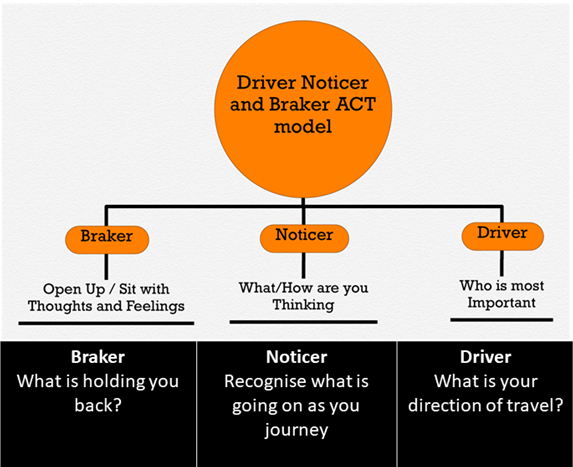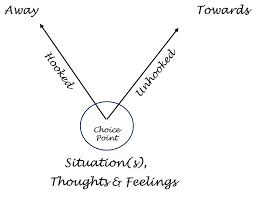Prevention is Better than Cure
An Introduction to ACT Training by Daniel Farmer
I have previously heard ACT described as ‘Mindfulness with purpose’.
The aim of ACT is to identify what’s important, create awareness to know when you’re on and off track and learn how to manage (accept and defuse) the times when the mind is trying to pull you off track.
Ultimately a combination of these three things helps us to develop Psychological Flexibility in the face of daily challenges and hassles; this can lead to greater resilience in the face of more challenging events in our lives.
It is worthwhile noting that prevention is always better than cure; so while ACT is used as a tool in therapeutic interventions, learning to implement ACT processes can help to minimise the impact of traumatic incidents which, unless we are extremely lucky, will happen to us all at some point in all our lives. It is almost inevitable.
I have put the three elements of direction, awareness and acceptance/defusion together in a model known as the Driver, Noticer and Braker model which is a metaphor for an individual running their own life; having a direction and committing to it, realising when they are off track and when and when not to apply the brake.
Driver, Noticer & Braker ACT Model
Developed by Daniel Farmer, adapted from the ACT Tri-Flex (Dr Russ Harris) and the ACT Matrix (Dr Kevin Polk).

The goal of ACT is to promote PSYCHOLOGICAL FLEXIBILITY.
Having flexible thinking in the face of adversity. Recognising that it is possible to have flexible thinking even when our minds are telling us to behave in a certain way. Having awareness that we do have choice.
ACT, whilst made up of a number of constituent parts, is ultimately a Process. It does not try to directly change our view of a situation, challenge or suffering that we are experiencing; rather the Process may help us to change our relationship with whatever is causing our suffering.
The model below is a metaphor for life. We are all the pilots (drivers) of our own lives. There are 3 discreet elements to the model:
The Driver element: hands on the wheel setting the course or direction.
The Noticer element: the awareness of the journey and what is going on inside and outside the vehicle.
The Braker element: ready to slow up the vehicle if things get a bit scary.
Driver
Hands on wheel, setting a direction of travel.
In order to set a course we need to have an idea of the destination. This is rarely a destination we can ever reach; rather something that we strive for. For example, I can never reach the end game of being a good parent; that is something
I will strive for as long as I am able. But being aware of that desire to be a good parent allows me to set a direction along with milestones and pitstops (goals and actions) on that journey. We are bombarded by so many expectations
in our lives that being able to cut through a lot of that and focus on what is important can be very liberating; freeing us from what is frankly a lot of background noise nonsense.
The video below highlights the difference between Values (Direction) and Goals (Milestones). It’s important to separate them.
Noticer
Looking around; being aware of your surroundings.
Without going into the specifics research has shown that regularly connecting with our present moment experience not only enhances our feelings of wellbeing and reduction in anxiety but creating awareness through mindfulness gives us another huge benefit. CHOICE.
When we act mindlessly we follow traditional rigid patterns of behaviour that do not give us a choice.
If we have awareness we have choice; this allows us to choose whether we go in the direction of who/what is important to us or away from that.
I am sitting here writing this at my computer at 9:30am on a beautiful Sunday morning. I am suffering with hay fever and was snoring so badly last night that I kept waking myself up and forcing my partner to retreat to another room. Before I started on this today I didn’t particularly want to do this, but I have a discreet set of values and this website is something that is important to me. Within 15 minutes of starting this morning I was grateful to be sitting here doing something that had true value to me.
This why I feel ‘Mindfulness with a purpose’ is quite an apt description; learn to recognise what is important in your life; develop awareness (through mindfulness) to drive Choice.
This is shown clearly in the simple Choice Point model developed by Dr Russ Harris.

When thoughts, feelings, and situations crop up which are difficult and unpleasant we are either hooked into our traditional way of responding or we can choose how to respond.
Getting Hooked by thoughts and feelings takes us Away from what is important
Getting Unhooked from thoughts and feelings helps to take us Towards what is important.
Braker
When and when not to apply the brakes.
Whether we get Hooked on or Unhooked from our thoughts and feelings is one of the significant brakes to living in line with what is important to us. Identifying what we are thinking is only part of the story.
If our minds are telling us to behave in a particular way we are likely to listen; it is our own minds after all.
The trouble is that for many of us our minds drive to keep us safe closes off opportunities and the whole experience of life. As Steven Hayes the father of ACT wrote “Get out of your head into life”.
The mind wants to put the brakes on our activities in an effort to keep us safe. Sometimes this is appropriate if we’re taking part in reckless or dangerous behaviour; however much of the time the thoughts are such things as, “don’t bother you’re not good enough” or “trying always ends in failure for you”. The reality is such statements are untrue.
There are a number of techniques used to help us unhook from unhelpful thoughts and they all involve turning towards what is bothering us. I have provided a link here to one of the most useful which helps to create space between you
as the conscious mind and the thought and in doing so diminishes the thought’s power.
Summary
Build resilience through ACT processes
In summary if we can:
]]]] identify what is important to us
]]]] cultivate awareness of how we’re thinking
]]]] and ease up on the brakes that are holding us back
then we can get out of our heads and into lives and create more opportunities than we might have ever dreamed possible.
We suddenly start to see challenges as chances to expand our horizons and reframe difficult situations as times when we can learn and grow and create a different perspective on our lives.
Now the fun bit…
Interestingly this reframing is something done by many stand-up comedians who take seemingly mundane life situations and, with a little reframe to change our perspective, turn that into comedy gold. Two great proponents of this are Stewart Francis and Milton Jones. Here are a couple of their videos to raise a smile 🙂
Further Information
If you want to access to further information and videos on ACT please click on the Resources… button